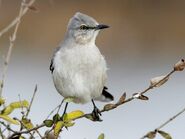Northern Mockingbirds are well known for their singing; often mimicking other birds' songs and singing endlessly, even at night.
Appearance[]
Northen Mockingbirds are medium-sized slender songbirds with a long gray tail with white outer tail feathers, long, thin bill with a hint of a downward curve, and long legs. Adults have greyish upperparts and whitish underparts with two white wingbars. A large white wing patch on their short, rounded, and broad wings can be seen during flight. Juvenile mockingbirds have spotted breasts.
Northern Mockingbirds are 8.3-10.2 in (21-26 cm) in length and weigh 1.6-2.0 oz (45-58 g). They have a wingspan of 12.2-13.8 in (31-35 cm).
Occurrence[]
Northern Mockingbirds prefer open, grassy land at low elevations. They don't migrate.
Life History[]
Food[]
These mockingbirds are omnivorous, eating mainly insects in summer but switch to eating mostly fruit in fall and winter.
Nesting[]
Northern Mockingbirds nest in shrubs and trees, typically 3-10 feet off the ground but sometimes as high as 60 feet. The male probably chooses the nest site and begins building several nests before the female chooses one to finish and lay eggs in. The female may start laying another clutch in a second nest while the male is still caring for fledglings from the previous one. Northern Mockingbirds rarely ever reuse their nests.
Mockingbird nests consist of dead twigs shaped into an open cup, lined with grasses, rootlets, leaves, and trash. The male constructs the twig foundation while the female creates most of the lining.
Northern Mockingbirds will have 2 to 3 broods with 2-6 eggs in each. The eggs are pale blue or greenish white splotched with red or brown. They have a length of 0.8-1.1 inches (2-2.9 centimeters) and a width of 0.6-0.8 inches (1.6-2 centimeters). The incubation period for mockingbirds is 12-13 days and nesting period is 12-13 days.
After the eggs hatch, the nestlings are naked, blind, and helpless with light gray down.
Behavior[]
Northern Mockingbirds are found alone or in pairs throughout the year. They like to make their presence known, sitting and singing atop shrubs, trees, utility lines, fences, and poles. On the ground they walk, run, and hop, tail cocked upwards, grabbing at prey or snatching insects just over the grass. Mockingbirds sometimes fly up and hover to grab at hanging fruit.
The Northern Mockingbird is aggressive throughout the year. Females typically fend off other female mockingbirds, while males confront male intruders. Males disputing territory boundaries fly toward each other, land near the boundary, and face off, silently hopping from one side to another. Eventually, one bird retreats and the other chases it a short ways. If neither bird backs off, they may fly at each other, grappling with wings and claws and pecking at their attacker. Mockingbirds are also territorial around other bird species as well as dogs and cats.
The flight style of mockingbirds is variable but generally leisurely, with showy wingbeats. Sometimes Northern Mockingbirds simply drop quickly from a perch with their wings folded.
Sounds[]
Both male and female mockingbirds sing. They often mimic the sounds of birds (and frogs) around them. They will continue learning new sounds throughout their lives.
Their song is a long series of phrases, with each phrase repeated 2 to 6 times before shifting to a new sound. The songs can go on for 20 seconds or more. Many of the phrases are whistled, but mockingbirds also make sharp rasps, scolds, and trills. Unmated males are the most insistent singers, carrying on all day and late into the night.
Northern Mockingbirds make a harsh, dry chew or hew when mobbing predators or chasing other mockingbirds. Mates produce a softer version of this call during incubation and nestling periods, or when the female leaves the nest during incubation. Mockingbirds also make a series of 2 to 8 short, scratchy chat calls to warn off intruders. Females make a single chat when disturbed.
Status[]
Northern Mockingbirds are widespread and common, though their populations are declining.
Gallery[]
Trivia[]
- In the nineteenth century, people kept so many mockingbirds as cage birds that the birds nearly vanished from parts of the East Coast. These extraordinary singers could be sold for as much as $50.
- A male mockingbird may learn around 200 songs throughout his life.
- The Northern Mockingbird frequently gives a "wing flash" display, where it half or fully opens its wings in jerky intermediate steps, showing off the big white patches. No one knows why they do this, and different mockingbird species do this same display even though they don’t have white wing patches.
- Northern Mockingbirds sing all through the day, and often into the night. Nighttime singing is more common during the full moon.
- A male may have two distinct variations of songs: one for spring and another for fall.
- The female Northern Mockingbird sings too, although usually more quietly than the male does. She rarely sings in the summer and sings more in the fall.
- The oldest Northern Mockingbird recorded was around 14 years, 10 months old when it was found in Texas.
- Northern Mockingbirds are also called Sinsonte Norteño (in Spanish) and Moqueur polyglotte (in French).






